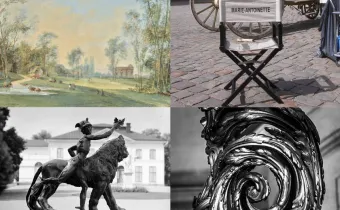The King’s bedchamber: an important space with a complex past
In 1678, Louis XIV decided to build the Hall of Mirrors, the War Room and the Peace Room, and rebuild the façade on the Marble Courtyard. This process paved the way for a major reshuffling of the royal residence’s central spaces. As a result of these works, the large central salon between the Marble Courtyard and the Italian-style terrace overlooking the gardens was opened out onto the Hall of Mirrors by three arcades with doors.
In 1684, this room running alongside the sovereign’s bedchamber, located in the present-day OEil-de-Boeuf antechamber, became the “King’s dressing room ”. Nine paintings from the incredibly dense collection that the Sun King compiled from the start of his reign were put on display on the room’s attic décor, meaning the upper levels of the walls.
In 1701, Louis XIV decided to rearrange his private apartment again, modifying the previous salon by ordering Jules Hardouin-Mansart to “shape an intricately carved wooden balustrade in the salon to house the King’s bed and become the bedchamber”.
The bedchamber’s location and position at the centre of the Palace and royal apartment is highly symbolic: it is east-facing, making it the starting point for the sun — Louis XIV’s symbol — as it sails across the sky. As it was the place of King's levee and of the King's going-to-bed ceremony, the room was an important is structuring courtly etiquette.
Essential components of the salon’s 1684 décor were preserved during these works, with the panelling, cornices, pilasters and doorframes all kept, as were the paintings displayed on the attic. The King kept a close eye on how works progressed, and decided to keep five of the salon’s existing Valentin de Boulogne paintings. However, due to the gilded stucco relief added over the bed, two paintings by Giovanni Lanfranco and Valentin de Boulogne were removed, as well as one attributed to Nicolas Tournier.
These changes point to Louis XIV’s taste for Caravaggisti painting, which he chose to keep here in this highly personal and symbolic room. With their stark compositions and touches of genius, these pieces play on shadow density and contrast beautifully with the room’s opulent, gilded décor.
Masterpieces brought back to life
One of the Palace of Versailles’ most-admired rooms, the King’s bedchamber, is better known for its symbolic presence than for the masterpieces it contains. This exhibition sets out to lend the paintings the visibility they deserve by giving visitors the chance to admire them at eye level for the very first time.
Thanks to pieces on loan from the Louvre Museum and the Musée de Tessé in Le Mans, the Palace of Versailles brings together, for the very first time, the nine paintings that would have hung in the room from 1684 to 1701, alongside of the four overdoor medallions. Some of this nine masterpieces are still displayed here today.
Exhibition commissioner
Béatrice Sarrazin, Heritage Curator at the Musée National des châteaux de Versailles et de Trianon
Partners media
![]()
![]()
![]()
![]()





